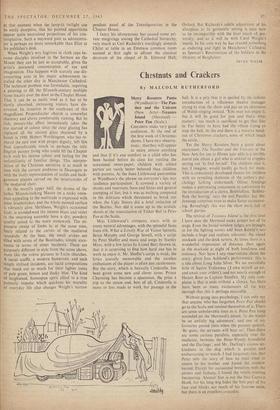Manchester's Christ
IT is undeniable that British painters with a specifically Christian mes- sage in their pictures tend to be individualists to the point of eccentricity. Sutherland is not a case in point, for credulity has no part in his compleX make-up. Coventry apart his religious symbolism has been a vent for
deep-seated frustration. Clearly one thinks no of Stanley Spencer and, to come to the present of Card l Weight, Craigie Aitchison and Franc' Hoyland. In varying degrees, the awe of th primitive masters has stimulated their consciou ness to help them to express their private faiths
Card l Weight's interests as Professor of Paint ing at the Royal College have never modifie his quirkish quality of imagination. He is sus tamed in his isolation by the certainty that grea English artists have been the oddest men out Blake, Turner, Spencer float in his luminou dome. Some day Weight's religious imagery ma be assembled and properly evaluated as a natura extension of his unworldly apprehensions of life Ghosts and marvels hover around -his runcibl hat even, one suspects, in the rush-hour o Earls Court platform. His furtive little figure heighten the queer foreboding of scenes as fres and directly painted as his canvases set up in th Provençal countryside. It is particularly in hi changing South-West London of doomed Vi torian mansions under skies of puce and lemo
at that moment when the lamp-lit twilight can be eerily deceptive, that his painted apparitions appear quite unstrained projections of his con- templation. Such a wayward poet as administra- tor is perhaps no more remarkable than Eliot at his publisher's desk.
When Weight's wry fugitives in cloth caps be- come disciples involved in the Sermon on the Mount they can be just as acceptable, given the artist's sustained concentration of eye and imagination. This happens with scarcely one dis- concerting note in his major achievement in- stalled the other day in Manchester Cathedral. The technical problem was formidable, requiring a painting to fill the fifteenth-century multiple stone tracery over the door to the Chapter House. That it can be as easily read as it has to be slowly absorbed, increasing visitors have dis- covered. Its situation in the south-east of this magnificent Perpendicular church is somewhat shadowy and above comfortable viewing. But its rich, mosaic-like effect immediately takes the eye starved of colour since the clear glazing has replaced all the stained glass shattered by a bomb in 1940. Hubert Worthington, who has re- stored the east end with proper dignity, left this final unpredictable touch to perhaps the only English painter living who could fill the Chapter arch with his intense colour and feeling for the unfamiliarity of familiar things. This interpre- tation of the Christian narrative is as much in tune with the current problems in Deansgate as With the lively representation of scolds and back- gammon players carved on the misericordes of the medixyal choir.
In the mural's upper half, the drama of the rather Minton-looking Master on a rocky emin- ence appealing to the multitude is expressed with tense brushstrokes, and the whole painted surface is vibrantly alive. Shrillness, Weight's occasional fault, is avoided 'and the intense blues and violet in the swarming assembly have a dry, powdery quality suited to the worn stonework. The ex- pressive sweep of limbs is, at the same time, finely related to the curves of the medieval spandrels. At the base, the small arches are filled with seven of the Beatitudes, simple state- ments in terms of street incidents. These are purposely different in style from the scene above, more like the votive pictures in Latin churches. A racial scuffle, a modern Samaritan, and such simply stylised incidents, are lucid compositions that stand out as much for their lighter tones of pale green, lemon and dusky blue. The kind of heightened, homespun spirit allied to a true Painterly impulse which quickens his morality of everyday life also changes Weight's narrow
pendant panel of the Transfiguration in the Chapter House.
I fancy his idiosyncrasy has caused some pri- vate misgivings among the Cathedral hierarchy, very much as Ceri Richards's startlingly donnish Christ at table in an Emmaus common room seemed at first sight to affront the classical decorum of the chapel of St. Edmund Hall, Oxford. But Richards's subtle adjustment of his altarpiece to its geometric setting is seen now to be incompatible with the least touch of per- versity, and so it will be with Carel Weight's mural. In his own way he has created something as enduring and right in Manchester Cathedral as Spencer's Resurrection of the Soldiers in the Oratory of Burghclere.
NEVILII \VALLIS































 Previous page
Previous page